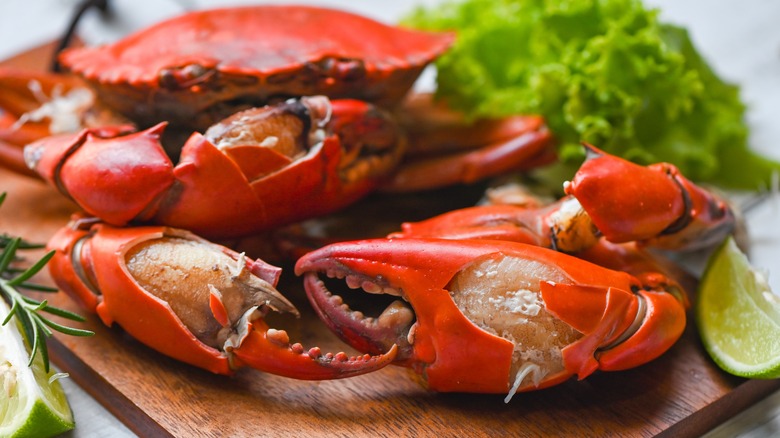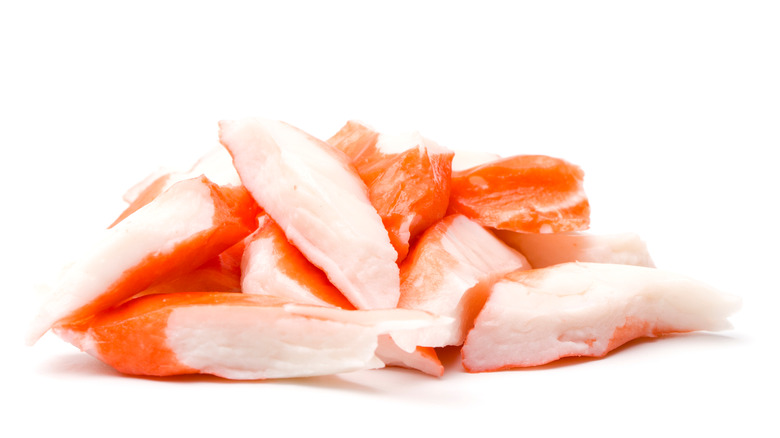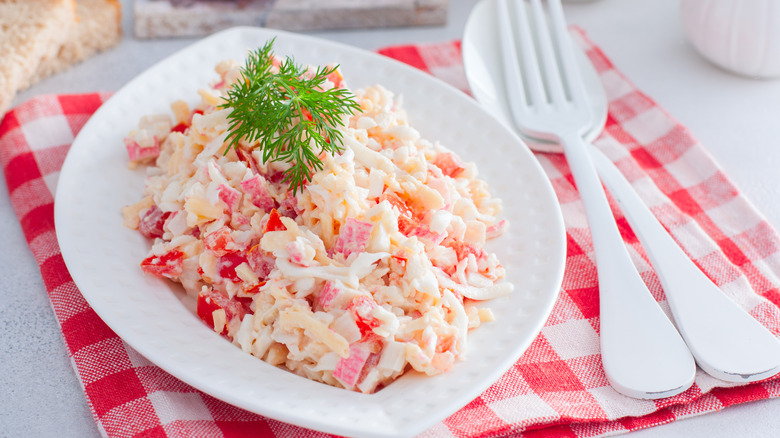The Case Against Ordering Crab-Based Meals At Restaurants
At some point in human history, people started plucking creepy crawlers with a penchant for pinching out of the sea and decided they looked good enough to eat. Fast-forward to today, and you find that crab is a beloved delicacy the world over — one that people are willing to pay a hefty price to consume. Still, restaurants have operating expenses to consider, and the unpredictable fluctuation of cost has created a need for imitation crab that meets business needs while satisfying diners.
So what is imitation crab, and what makes it more affordable? While it doesn't contain any real crab meat, imitation crab is made with the flesh of different white fish, including Alaskan Pollock, cod, or tilapia. The minced paste comprising these fish then gets a cocktail of ingredients such as starches, egg whites, sugar, salt, and other natural and artificial flavors added to it. Although its taste and appearance (when shredded) adequately approximate real crab, it is mostly filler and no killer. Since its creation in the '70s, it has progressively made its way onto more restaurant menus under the guise of crab-based sides and appetizers. These dishes may save you a few dollars and not taste that bad, but there is still a case to be made against ordering them.
Real crab vs. imitation crab
Besides the dissatisfaction inherent in eating the fake version of something, having to choose between the two carries some nutritional implications. There are a few things that stand out when looking at the nutrition facts of imitation crab. First of all, it contains added sugar, something real crab does not contain. If you want to cut down on overall sugar consumption, imitation crab is not the ideal cheap protein to reach for. When you consider that dishes like California Rolls and crab salads are meant to be on the more nutritious side, the added sugars in imitation crab meat don't help their cases as healthy alternatives.
Secondly, the overall macro-nutrients of imitation crab compared to the real thing don't fare any better. While they are nearly identical in calories (around 80 grams per serving), there is less overall nutritional value in imitation crab. Clocking in at 18 to 20 grams per serving, real crab meat contains nearly three times more protein than imitation crab, which makes it an excellent food for those on a high-protein diet. And while imitation crab contains less fat, it is almost completely devoid of healthy fats like essential omega-3 fatty acids found in real crab — not to mention all the other vitamins and minerals you're missing out on by eating imitation crab.
How to tell imitation crab from real crab
How can you tell if you're getting imitation crab or the real thing before ordering? Ideally, restaurants will be transparent and indicate on the menu that a dish contains it. Some popular restaurant dishes that commonly contain imitation crab include crab rangoon, crab salads, crab omelets, and various sushi rolls. Although some of these menu items effectively mask the signature artificial orange color of imitation crab or the unmistakable chewiness of factory-made meat, you can be sure you're not eating the real thing is if it's called "krab" on the menu.
If these indicators are nowhere to be found, the final sure-fire way to assume you're being served the imitation crab is the price. If the price tag of a dish doesn't blow your hair back, it's probably safe to say the dish is sans crab. If the price does blow your hair back, and you find imitation crab in your dish anyway, never return to that restaurant. The main takeaway here is that if you're not that bothered about what kind of crab meat you're eating, you can order to your heart's content. Just make sure that you're getting what you pay for.


